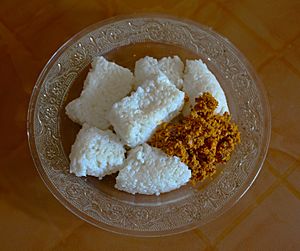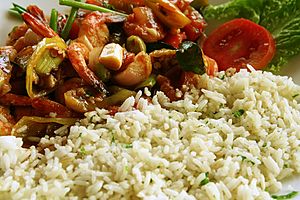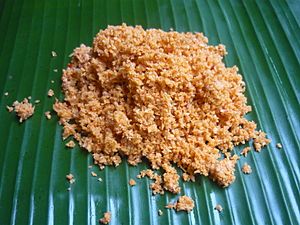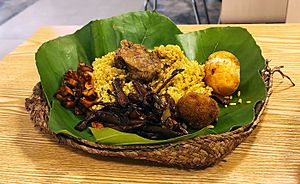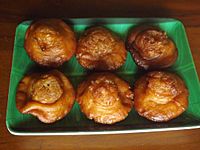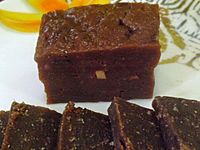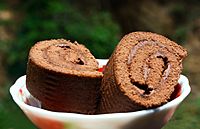Sri Lankan cuisine facts for kids
Sri Lankan cuisine is famous for its special mix of herbs, spices, fish, vegetables, rice, and fruits. The food often uses many kinds of rice. Coconut is also a very common plant across the country and is used a lot in cooking. Food from the sea, like fresh fish or dried fish, is also a big part of the meals.
Sri Lanka was once a busy stop on the old Silk Road for ships. Because of this, traders from other countries brought new foods and ideas. These new things, along with the local traditions, helped shape Sri Lankan cooking. You can see influences from Indian (especially South Indian), Indonesian, and Dutch cuisines. Sri Lankan food is closely related to other foods from South and Southeast Asia.
Sri Lanka was historically known for its cinnamon. The true cinnamon tree, or Cinnamomum verum, was even named Cinnamomum zeylanicum because it came from Sri Lanka. This spice is used a lot there. It has a sweet, delicate taste, different from the cinnamon found in some other South Asian foods. Sri Lankan cooking uses special spice mixes, lots of Sri Lankan cinnamon, and black pepper. It also uses unique ingredients like maldive fish, goraka (a sour fruit), pandan leaf, lemongrass, and jaggery (a type of sugar) made from kithul palm syrup. Many kinds of red rice are eaten in Sri Lanka, some of which are very old and special. Tea is also a very important drink, and Sri Lanka makes some of the best tea in the world.
Contents
Where Food is Different
Along the coasts of the island, seafood is a common part of local dishes. Tamil cuisine, especially in Jaffna, is quite similar to South Indian cuisine. In the hill country, Kandyan Sinhalese cooking uses many local vegetables and fruits from the mountains.
Common Ingredients
Sri Lankan food uses a wide range of ingredients to create its unique flavors:
Spices: True cinnamon, black pepper, fennel, cardamom, cloves, fenugreek, nutmeg, mace, cumin, coriander, turmeric.
Herbs: Pandan leaf, shallot, goraka, lemongrass, tamarind, garlic, ginger, curry leaf, lime, cayenne pepper, tabasco pepper.
Fish: Maldive fish (dried fish), dried fish, mackerel, tuna, shark, sprats, fermented preserved fish.
Grains: White rice (like Samba, Kekulu, Suwandel), red rice (like Kekulu, Pachchaperumal, Kaluheenati, Madathawalu), finger millet, hog millet, olu haal (water lily seed).
Oils: Coconut oil, sesame oil, cow ghee, buffalo ghee, mustard oil.
Sweeteners: Kithul jaggery, coconut jaggery, palmyrah jaggery.
Vegetables and Greens: Gotukola, green papaya, snake beans, bitter melon, snake gourd, luffa, pumpkin, winged bean.
Meats: Chicken, pork, goat meat, beef.
Roots and Tubers: Lotus root, purple yam, tapioca, kohila (a local plant), Arrowleaf elephant's ear.
Other: Coconut milk and grated coconut are used everywhere. They are often prepared fresh daily. Maldive fish is used in vegetable dishes to add a savory, rich taste called umami.
Fruits: Bananas, mangoes, pineapple, soursop, guava, avocado, orange.
Popular Dishes
Rice and Curry
The main meal in Sri Lanka is boiled or steamed rice. It is served with a curry of fish or meat. There are also other curries made with vegetables, lentils, or fruits.
These dishes often come with pickled fruits or vegetables, chutneys, and sambols. Coconut sambol is very common. It is a paste of ground coconut mixed with chili peppers, dried Maldive fish, and lime juice.
Kiribath
Kiribath (which means 'milk rice') is rice cooked in salted coconut milk until it becomes soft like porridge. People usually eat kiribath for breakfast. It is also made for special events like birthdays, New Year's, and religious festivals. It is often served with lunu miris, a spicy paste made from red onions and chilies. Sometimes, kiribath is cooked with mung beans. During the Sinhalese/Tamil New Year, kiribath is served with sweets like kavum and kokis.
Kottu
Kottu is a spicy stir-fry dish. It is made from shredded roti bread mixed with vegetables. You can also add eggs, meat, or cheese. It was first made in Batticaloa. In Tamil, 'kottu' means 'chopped roti'.
Hoppers
Hoppers (called appa in Sinhala) are made from a fermented batter. This batter is usually made from rice flour and coconut milk with spices. The dish is cooked in a pan or steamed. The batter ferments using palm toddy (a palm tree sap) or yeast. Hoppers can be spicy, like egg hoppers and string hoppers. They can also be sweet, like vandu appa. Spicy hoppers are often eaten with lunu miris, which is a mix of red onions and spices.
String Hoppers
String hoppers (idiyappa in Sinhala) are made from a dough of rice meal or wheat flour mixed with hot water. The dough is pressed into thin circles using a special mold onto small mats, then steamed. This dish is usually eaten with a curry, such as Kiri hodi.
Lamprais
Lamprais is a dish influenced by the Dutch Burghers. It includes rice boiled in stock, frikkadels (meatballs), a mixed meat curry, blachan, eggplant curry, and seeni sambol. All these ingredients are wrapped in a banana leaf and baked in an oven. Lamprais is great for special gatherings because it is rich and takes time to prepare. It is cooked twice: first, the rice and other parts are cooked separately. Then, everything is wrapped in a banana leaf and baked, which makes it a unique dish.
Kool
Kool is a seafood soup from Jaffna. It contains crab, fish, cuttlefish, prawns, and crayfish. It also has long beans, jak seeds, manioc, spinach, and tamarind. The soup is made thicker with palmyra root flour.
Pittu
Pittu are cylinders of steamed or roasted rice flour mixed with grated coconut.
Roti
Godamba roti is a simple Sri Lankan flatbread usually made from wheat flour.
The most popular roti is Pol roti, where shredded coconut is mixed into the dough. Another type is spicy roti, which has chopped onions and green chilies in the dough.
Sambal
Sambals (called Sambol in Sinhala) are eaten with many dishes, including curries and string hoppers. Seeni sambol, Pol sambol, Lunumiris, Gotukola sambal, and Vaalai kai sambal are common sambols found in Sri Lanka.
Mallung
Mallung is a side dish or condiment. It is made of chopped greens that are lightly cooked and mixed with grated coconut and red onions.
Malay Achcharu
Malay Achcharu, also known as Sri Lankan Malay pickle, came from the local Malay community. Now, it is very popular among all groups in the country. It is a mix of vegetables in a pickled sauce, blending sweet, sour, and spicy tastes.
Babath
Babath is a dish made from the stomach of cattle or goats. It is cooked as a curry or deep-fried and eaten with rice or with Pittu. This dish is linked to the Sri Lankan Malay community and is also very common among the Moor community.
Sate
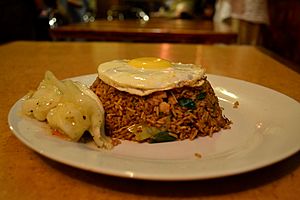
Sate comes from Malay cooking and has become a common food in Sri Lanka. These are served with peanut and chili sauce.
Nasi Goreng and Mee Goreng
Nasi goreng and Mee goreng are popular street foods in Sri Lanka. They became popular due to influences from Indonesia and the local Malay community.
Sweet Treats
A common dessert in Sri Lanka is kevum. It is an oil cake made with rice flour and treacle (a thick, sweet syrup). It is deep-fried until golden brown. There are many kinds of kevum. Moong Kevum is made from mung bean flour, shaped like diamonds, and then fried. Other types include athiraha, konda kevum, and handi kevum.
Many sweets are served with kiribath (milk rice) during the Sinhalese and Tamil New Years. Other sweets include:
Cakes and Pastries:
- Aluwa - Diamond-shaped pastries made from rice flour.
- Bibikkan - A rich, cake-like sweet made from grated coconut, coconut treacle, and wheat flour. It is a special treat from coastal areas.
- Kokis - A crispy, biscuit-like dish made from rice flour and coconut milk.
- Pushnambu / Wandu Appa - A rich, cake-like sweet made from coconut treacle and wheat flour. Cinnamon, cardamom, and sweet cumin are often added by Christian people in Sri Lanka.
- Seenakku - A sticky rice cake often served with grated coconut.
Treacle-Flavored Sweets:
- Undu Walalu/Undu wal or Pani walalu - A sweet from the Mathale area. It is made using urad bean flour and kithul treacle.
- Aggala - Rice balls flavored with treacle.
- Weli Thalapa - Made from rice flour and coconut treacle.
- Aasmi - Made with rice flour and the juice of a leaf called dawul kurundu (or okra juice). It is deep-fried and topped with pink-colored treacle.
Puddings and Toffees:
- Kalu Dodol - A solid, jelly-like sweet. It is made by cooking coconut milk for a long time, thickening it with rice flour, and sweetening it with jaggery.
- Watalappam - A steamed pudding made with coconut milk, eggs, and jaggery. It was first brought by Malay immigrants and is now a favorite Sri Lankan dessert.
Other Sweets:
- Thala Guli - Made from ground sesame and jaggery with finely grated coconut.
- Kiri aluwa or Milk Toffee - Made with sweetened condensed milk or sugar-thickened cow's milk. Cardamom and cashews are added for more flavor.
- Sri Lankan sweets
Quick Bites
"Quick bites" are a variety of snacks. People often buy them from special shops and restaurants. They are eaten on the go, usually for breakfast or in the evening.
Quick bites include pastries, Chinese rolls, and patties. Other quick bites are:
- Vade - like parippu vade, ulundu vade, isso (shrimp) vade, crab vade.
- Chinese rolls or egg rolls, which often have minced meats, potatoes, and vegetables inside.
- Patties and pastries - filled with vegetables, meat, or fish.
- Vegetable/fish roti - a flatbread with a filling, folded into a triangle, and baked.
Quick bites are served at parties or when guests visit a home. Western fast-food like hot dogs and hamburgers are now in Sri Lanka, with chains like McDonald's and KFC. However, these are not usually seen as traditional quick bites. Also, hot dogs and hamburgers are often changed to fit local tastes.
Drinks
Drinks commonly served in Sri Lanka include:
- Faluda - a mix of syrup, ice cream, jelly pieces, and basil seeds, served cold.
- Fruit juice - including lime and passionfruit juice.
- King coconut water.
- Tea.
- Toddy - a drink made from palm tree sap.
- Arrack - a spirit made from the fermented sap of the coconut flower.
- Wood Apple juice.



